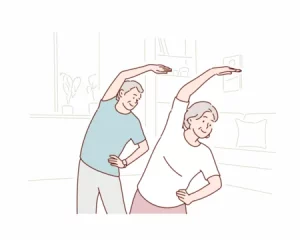 Have you ever thought about why we have a brain? The obvious answer might be “to think”. But scientist Daniel Wolpert came up with a completely different explanation at the 2011 meeting of the Society for Neuroscience:
Have you ever thought about why we have a brain? The obvious answer might be “to think”. But scientist Daniel Wolpert came up with a completely different explanation at the 2011 meeting of the Society for Neuroscience:
“We have a brain for one reason and one reason only: to produce adaptable and complex movements”
Use your brain to stay efficient
The brain, in other words, is the orchestra conductor which orders the body’s movements. We call the faculties that allow us to interact with our environment cognitive abilities. These include concentrating, learning, reasoning, adapting and communicating with others. Every one of them is key in enabling us to go about our routine and help us maintain a good lifestyle.
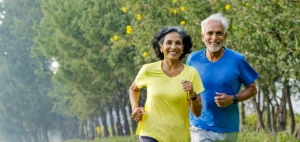 So, how can we best take care of our brains so that they can stay as efficient as long as possible? Contrary to popular belief, the brain does not deteriorate continuously with age. Instead, it only sees the number of its brain cells drop and connections deteriorate from the age of 45 onwards as part of a normal ageing process. But cerebral plasticity, although reduced, is present until the end of life. Each individual will build up a cognitive reserve throughout their lives.
So, how can we best take care of our brains so that they can stay as efficient as long as possible? Contrary to popular belief, the brain does not deteriorate continuously with age. Instead, it only sees the number of its brain cells drop and connections deteriorate from the age of 45 onwards as part of a normal ageing process. But cerebral plasticity, although reduced, is present until the end of life. Each individual will build up a cognitive reserve throughout their lives.
The more positive, rich and stimulating the lifestyle, the more powerful and effective the reserve. In other words, it’s possible to moderate the effects of age on cognition.
The benefits of physical activity on cognitive capacity after 60
In fact, much research shows indeed that physical activity improves cognitive capacity, 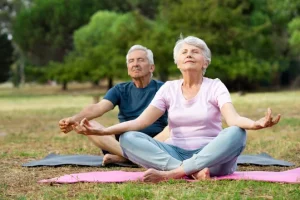 even after the age of 60. From increased memory, better reactivity to greater planning skills, the benefits are endless.
even after the age of 60. From increased memory, better reactivity to greater planning skills, the benefits are endless.
Despite this, few older folks engage in physical education adapted to their bodies on a regular basis. Poor motivation and access to these exercises are some of the factors that don’t help.
With that in mind, many carers might be tempted to offer older people monotonous, routine activities because of their diminishing physical, cognitive and sensory abilities. And indeed, for a long time, the range of sports on offer and research in this field revolved around the same triptych: gentle gymnastics, walking and yoga. However, you’ll reap more benefits by combining different training methods.
Three ingredients to train the brains of senior citizens
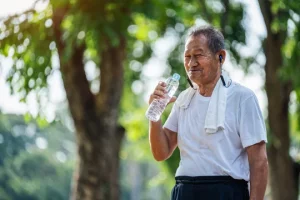 Researchers are currently attempting to crack the winning formula that would flex older people’s cognitive, as well as physical muscles. It’ll consist of three main ingredients:
Researchers are currently attempting to crack the winning formula that would flex older people’s cognitive, as well as physical muscles. It’ll consist of three main ingredients:
First ingredient: complex physical and motor stimulation of at least moderate intensity.
Moderate cardio workouts not only improve cardiorespiratory health but also make the brain more efficient. Overall improved cardiofitness, in turn, allows the brain to receive more oxygen and even to generate new neurons in the hippocampus, where memory is lodged.
It therefore makes sense for programmes designed to boost cognitive function to include cardio. But it is also necessary to combine them with muscle-strengthening, flexibility and balance exercises to achieve greater benefits. In addition, the researchers emphasise the 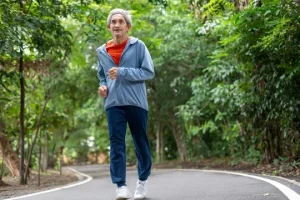 importance of adding situations requiring complex motor skills and coordination, as these would have a significant impact on cognitive functions (e.g. memory, attention and mental flexibility), particularly in the elderly.
importance of adding situations requiring complex motor skills and coordination, as these would have a significant impact on cognitive functions (e.g. memory, attention and mental flexibility), particularly in the elderly.
Second ingredient: fire up those brain cells during exercises
Incorporating cognitive stimulation, such as remembering information for a period of time and executing it, anticipating actions, or planning a move, is another winning strategy. When cognitive stimulation is combined with physical activity, it can produce synergistic effects and, as a result, be more effective on cognitive functions.
_Third ingredient: group activities that lead to social interaction. _
Working out as part of a group has been shown to help us persevere through it.
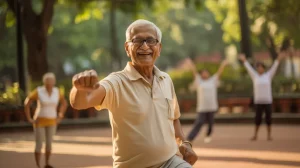 What this winning formula could look like in practice is still being researched. At present, there are two broad types of exercises that have caught our attention that could help older people stay sharp.
What this winning formula could look like in practice is still being researched. At present, there are two broad types of exercises that have caught our attention that could help older people stay sharp.
Opting for cooperative and oppositional team sports
Team sports offer much more than just physical exercise sessions. What’s particularly great about them is that they don’t only challenge cardiorespiratory balance, but tap into the whole body’s physical skill-set.
Take basketball or handball, for example: to move around the court, dribble or score, balance, coordination and flexibility are essential. Muscular strength is also required for passing, recovering the ball and moving around. These team sports can be suitable even after the age of 60, provided they are properly supervised.
From a cognitive point of view, these activities create situations that are always new, rich and stimulating. We call this double combination of stimuli simultaneous training. A number of researchers have highlighted the importance of this cognitive involvement in team sports and encourage their practice, particularly among the elderly.
Recent studies, such as the one carried out in 2022 by French researchers, have shown that participation in team sports improves short-term visuospatial memory (which enables people, for example, to remember the location of certain objects for a limited period of time) and planning skills in the elderly.
Get your body moving with exergames
Another promising avenue are exergames – video games that require players to move around to play. Named after the contraction of “exercise” and “games”, they grew popular in the 2000s thanks to Nintendo’s Wii and Switch and Microsoft’s Kinect.
Exo Games have been thought out to exercise different fitness skills, such as balance, endurance, strength, and coordination, while simultaneously stimulating cognitive functions. Among older people, several research studies show that this type of training helps to improve many physical and cognitive abilities.
In 2020, a new generation of exergames emerged, making use of interactive walls to create an even more immersive gaming experience, such as Neo Xperiences’ Neo-One, Sphery’s ExerCubeand Lü’s Aire interactive. In these games combining real and virtual worlds, physical objects (such as balls) and digital objects coexist and interact in real time.
A recent study compared an exergame programme assisted by an immersive wall with a walking and muscle-strengthening programme. Its results suggest that this new generation of exergames may be more effective on cognitive abilities than traditional training.
Combining physical and cognitive exercises offers the best chance to keep one’s brain health while keeping fit. This is essential for an active and fulfilling life, whatever your age. (The Conversation)



